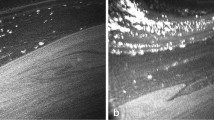Abstract
The complexity of the tear film covering the anterior surface of the human cornea has become increasingly evident with recent investigations into its structure and chemical composition. The three-layered structure proposed by Wolff1, perhaps useful as an approximation, is a considerable simplification of reality. While the oily lipid portion of the tear film usually forms a thin layer on the anterior surface of the tear film, as proposed by Wolff, the distribution of other components, such as mucins, appear to be not as well stratified. For instance, there is increasing evidence that a significant portion the mucin component, in highly-hydrated form, is present throughout the aqueous phase as well as being adherent, in a rather thick coating, to the surface of the epithelial layer of the cornea. This mucin coating is much thicker than that proposed by early investigators, at least 1 micron, and perhaps very much greater. Most of this mucin is probably restricted in its ability to freely enter the aqueous phase of the tear film. Thus, the fluid portion of the tear film is now often described as having two layers, rather than three. These consist of the floating lipid phase, secreted primarily by the meibomian glands within the eyelids, and the aqueous phase, a watery solution containing “everything else”, the major components being secreted by the main and accessory lacrimal glands.
Access this chapter
Tax calculation will be finalised at checkout
Purchases are for personal use only
Preview
Unable to display preview. Download preview PDF.
Similar content being viewed by others
References
E. Wolff. “Anatomy of the Eye and Orbit, 4th Edition,” Blakiston Co., New York (1954). P. 207.
H. Klipp, E. Schmid, L. Kirchner, and A. Zipf-Pohl, Tear film observation by reflecting microscopy and differential interference contract microscopy, in: “The Preocular Tear Film in Health, Disease, and Contact Lens Wear,” F.J. Holly, ed., Dry Eye Institute, Lubbock TX (1986). P. 564.
II. Hamano, M. Hori, II. Kawabe, M. Umeno, S. Mitsunaga, Y. Ohnishi, and I. Koma, Change of surface pattern of precorneal tear film due to secretion of meibomian gland, Folia Ophthalmol Jap. 31:353 (1980).
J. E. Josephson, Appearance of the preocular tear film lipid layer, Am. J. Optom. and Physiol. Opt. 60:883 (1983).
J.P. Guillon, Tear film structure and contact lenses, in: “The Preocular Tear Film in Health, Disease, and Contact Lens Wear,” F.J. Holly, ed., Dry Eye Institute, Lubbock TX (1986). P. 914.
M.G. Doane, An instrument for in vivo tear film interferometry, Optom Vis Science 66:383 (1989).
S. Mishima and D.M. Maurice, The oily layer of the tear film and evaporation from the corneal surface, Exp. Eye Res. 1:39 (1961).
F.J. Holly, Formation and rupture of the tear film, Exp. Eye Res. 15:515 (1973).
M.A. Lemp and J.R. Hamill, Factors affecting tear film breakup in normal eyes, Arch. Ophthalmol. 89:103, (1973).
I. Fatt and B.A. Weissman, “Physiology of the Eye. An Introduction to the Vegetative Functions, 2nd Edition,” Butterworlh-Heinemann, Boston (1992). P. 235.
D.R. Korb and A.S. Henriquez, Meibomian gland dysfunction and contact lens intolerance, J. Am. Optom. Assoc. 51:252, (1980).
Author information
Authors and Affiliations
Editor information
Editors and Affiliations
Rights and permissions
Copyright information
© 1994 Springer Science+Business Media New York
About this chapter
Cite this chapter
Doane, M.G. (1994). Abnormalities of the Structure of the Superficial Lipid Layer on the in Vivo Dry-Eye Tear Film. In: Sullivan, D.A. (eds) Lacrimal Gland, Tear Film, and Dry Eye Syndromes. Advances in Experimental Medicine and Biology, vol 350. Springer, Boston, MA. https://doi.org/10.1007/978-1-4615-2417-5_82
Download citation
DOI: https://doi.org/10.1007/978-1-4615-2417-5_82
Publisher Name: Springer, Boston, MA
Print ISBN: 978-1-4613-6025-4
Online ISBN: 978-1-4615-2417-5
eBook Packages: Springer Book Archive




